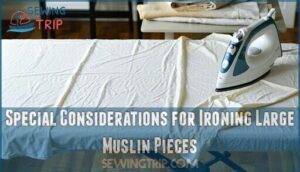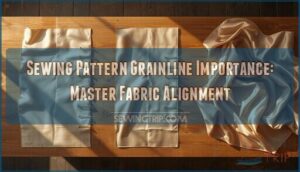This site is supported by our readers. We may earn a commission, at no cost to you, if you purchase through links.

Set your iron to medium heat (cotton setting) and use steam for best results. Muslin’s loose weave and cotton composition make it incredibly responsive to heat, smoothing out wrinkles like butter on warm toast.
Just use a pressing cloth on delicate varieties to prevent shine and maintain that soft texture you love. The secret lies in working with muslin’s natural properties rather than fighting them – this fabric becomes wonderfully pliable when heated, making your ironing session surprisingly satisfying.
Whether you’re prepping quilting squares or smoothing photography backdrops, muslin cooperates beautifully with proper technique and the right temperature settings.
Table Of Contents
Key Takeaways
- You can safely iron muslin using medium heat settings – Set your iron to around 275-300°F and use steam for best results without damaging the delicate cotton fibers.
- Always use a pressing cloth on delicate muslin varieties – This protective barrier prevents shine marks and scorching while maintaining the fabric’s natural softness and texture.
- Iron muslin while it is slightly damp for easier wrinkle removal – The moisture helps relax stubborn creases more effectively than dry ironing alone, making your job much simpler.
- Keep the iron moving constantly to prevent damage – Never let the iron sit stationary on muslin, as this can create permanent scorch marks, stiff spots, or shiny areas that ruin the fabric.
Ironing Muslin Fabric
You can safely iron muslin fabric using the proper temperature and technique to remove wrinkles without damaging its delicate fibers.
The key is using low to medium heat settings and adding steam or moisture to achieve professional results while protecting the fabric’s natural softness.
Safety Precautions for Ironing Muslin
Before starting your muslin ironing journey, prioritize fabric protection through proper heat control.
Set your iron to low or delicate settings around 300°F to prevent scorch prevention disasters. Always test on hidden fabric areas first—this simple step prevents costly burn risks.
**Test your iron on a hidden corner first—this simple step prevents costly disasters.
Use a pressing cloth as your safety net, creating a protective barrier between iron and muslin. Keep that iron moving constantly; stationary heat spells trouble for delicate fibers.
To maintain the quality of your muslin, follow the muslin care tips for washing and drying before ironing, ensuring proper care and delicate settings are used to prevent damage, and remember the importance of low heat.
Recommended Ironing Techniques for Muslin
Now that you’ve learned the safety basics, let’s master the actual ironing techniques for muslin.
Start by setting your iron to low heat and work in gentle, circular motions across the fabric. For stubborn wrinkles, lightly dampen the muslin first—this steaming method works like magic.
Always keep the iron moving to prevent scorching. These muslin ironing tips guarantee smooth results every time you tackle wrinkle removal on this delicate fabric.
Understanding proper jute ironing techniques can also help when working with similar natural fibers, ensuring you achieve the best wrinkle removal.
Choosing The Right Ironing Tools for Muslin
Right ironing tools transform muslin care from frustrating to fantastic.
You’ll need steam irons for effective wrinkle removal, sturdy ironing boards for stable surfaces, and fabric brushes to smooth fibers.
Ironing gloves protect your hands when pressing detailed areas, while muslin clips secure large pieces.
These muslin ironing tips guarantee you’ll iron muslin fabric like a pro every time.
Using the right steam iron models can make a significant difference in achieving professional results.
Can You Iron Muslin
Yes, you can absolutely iron muslin fabric safely with the right approach. This delicate cotton material responds well to proper ironing techniques, transforming wrinkled pieces into smooth, professional-looking textiles.
Many people worry about damaging muslin’s soft texture, but with careful attention to temperature and technique, you’ll achieve excellent results every time.
Here are three key points for successful muslin ironing:
- Use low to medium heat settings – High temperatures can scorch or shrink muslin fibers, so start with lower settings and increase gradually if needed
- Iron while slightly damp – Moisture helps relax stubborn wrinkles more effectively than dry ironing alone
- Consider a press cloth barrier – This prevents direct contact between the iron and fabric, protecting against shine marks or scorching
Whether you’re working with muslin curtains, backdrops, or garment pieces, the fabric responds beautifully to gentle pressure and appropriate heat. Remember that muslin’s loose weave makes it prone to wrinkling, but this same characteristic allows wrinkles to release easily when you apply proper steaming methods and fabric care techniques.
To maintain the quality of your muslin fabric, you must follow proper muslin washing guidelines before ironing to prevent shrinkage and damage.
Muslin Ironing Temperature
Getting the temperature right makes all the difference when ironing muslin—too hot and you’ll scorch the delicate fibers, too cool and those stubborn wrinkles won’t budge.
Setting your iron to low or medium heat (around 275-300°F) gives you the sweet spot for smooth results without damaging this cotton fabric.
Optimal Heat Settings for Muslin Fabric
When ironing muslin curtains or fabric, set your iron to low or delicate heat settings—typically 270-340°F for best results.
This fabric temperature prevents fiber damage while effectively removing wrinkles.
Steam ironing works wonderfully for muslin care, but avoid high heat that’ll scorch your delicate material.
These ironing tips guarantee your muslin fabric iron sessions maintain softness and quality every time.
For superior results with various materials, consider consulting heat press guides to understand the best temperature settings.
Avoiding Scorching and Damage to Muslin
Heat damage transforms your beautiful muslin into a crispy disappointment faster than you’d think.
Keep your iron’s temperature below medium heat – around 300°F works perfectly for muslin fabric iron settings. Watch for telltale brown spots that signal overheating.
When ironing muslin curtains or delicate fabrics, test a hidden corner first. Scorch prevention starts with proper heat control and fabric protection techniques.
To prevent damage, this is vital: follow proper delicate fabric care guidelines when working with muslin, ensuring proper heat control and fabric protection.
Using Steam to Iron Muslin Effectively
Steam transforms muslin ironing from a frustrating chore into a satisfying fabric care routine. You’ll master wrinkle removal by combining moisture with gentle heat, creating professional results every time.
Steam and gentle heat turn muslin ironing from nightmare to pure satisfaction.
Steam Ironing Muslin: Your 5-Step Success Guide
- Set your iron to low heat with maximum steam – High temperatures scorch muslin’s delicate fibers faster than you can say "oops"
- Keep the iron moving constantly – Stationary contact creates those dreaded shiny spots that make muslin look cheap
- Use a press cloth barrier – This thin cotton layer protects against direct heat while allowing steam penetration
- Iron while fabric’s slightly damp – Moisture activates muslin’s natural starch, making stubborn wrinkles disappear like magic
- Work in small sections systematically – Overlap each area slightly to guarantee complete wrinkle removal without missing spots
To achieve the best results, mastering the basics of a steam iron system is vital.
Ironing Muslin Backdrops and Squares
Large muslin pieces like backdrops and squares require special attention during ironing since their size makes them challenging to handle on standard ironing boards.
You’ll need to work systematically across sections, using proper support to prevent new wrinkles from forming as you iron previously smoothed areas, which is crucial for maintaining the quality of the muslin pieces, and this process involves systematically working across each section.
Special Considerations for Ironing Large Muslin Pieces
When tackling large muslin pieces, your workspace becomes your best friend.
Set up a sturdy, wide ironing board or flat surface to handle expansive fabric without cramping your style.
Roll excess muslin sections to prevent additional wrinkles while you work.
For muslin fabric care and bulk ironing tips, work one section at a time, keeping heavy portions from hanging off the board.
This approach prevents fiber distortion and guarantees even results across your entire piece, ensuring a professional finish with proper ironing techniques.
Removing Wrinkles From Muslin Backdrops and Squares
Large muslin pieces require patience and systematic approach for effective wrinkle removal. Work in sections to maintain control and achieve professional results.
- Start with damp muslin fabric – Spray lightly with water before ironing for easier wrinkle removal
- Use low heat settings – Set your iron to delicate or cotton setting to protect muslin fibers
- Iron in sections – Work from one corner to another, overlapping slightly for consistent results
- Apply gentle pressure – Let the iron’s weight do the work rather than pressing down hard
- Steam generously – Use steaming methods to relax stubborn creases without direct heat contact
Preventing Muslin From Losing Its Softness
Maintaining muslin’s natural softness requires careful temperature control and proper ironing techniques. You’ll preserve the fabric’s delicate fibers by using low heat settings and avoiding excessive pressure during the ironing process.
| Temperature Setting | Fabric Response | Softness Impact |
|---|---|---|
| Low (Cotton-1) | Gentle smoothing | Maintains original texture |
| Medium (Cotton-2) | Moderate wrinkle removal | Slight stiffening possible |
| High (Cotton-3) | Risk of fiber damage | Significant softness loss |
| Steam only | Minimal heat exposure | Best softness preservation |
| No heat/air dry | Natural relaxation | Maximum softness retention |
Your muslin fabric care depends on gentle handling throughout the ironing process. Keep the iron moving continuously to prevent heat buildup that can make cotton muslin stiff. When ironing delicate fabrics like muslin, use a press cloth barrier to protect the surface while maintaining the muslin iron temperature at its lowest effective setting. This approach guarantees your muslin fabric sewing projects retain their characteristic soft drape and comfortable feel, ensuring the fabric remains in its best condition with proper temperature control and ironing techniques.
Caring for Muslin After Ironing
Once you’ve successfully ironed your muslin fabric, proper aftercare becomes essential for maintaining its quality and appearance.
Store your freshly pressed muslin in a cool, dry place away from direct sunlight, and handle it with clean hands to prevent oil transfer that can attract dirt and cause premature wear.
Storage and Handling of Ironed Muslin Fabric
After ironing your muslin pieces, proper fabric folding and muslin storage become your best allies.
Roll backdrop muslin around cardboard tubes to prevent creasing, while smaller pieces benefit from flat storage between tissue paper.
Smart fabric organization means keeping ironed fabric care simple – store in cool, dry spaces away from direct sunlight.
Proper muslin handling prevents re-wrinkling, so avoid cramming pieces into tight spaces where fabric preservation strategies matter most.
Effective fabric storage methods are essential for maintaining the quality and longevity of your muslin fabric.
Maintaining The Quality of Muslin Over Time
Quality preservation becomes your muslin’s best friend when you embrace gentle handling practices.
Avoid overwashing—muslin naturally softens with each cycle, making harsh detergents unnecessary.
Store your ironed pieces flat or loosely folded to prevent deep creases.
Regular textile maintenance using proper iron settings protects fabric durability, and remember, muslin blends offer enhanced resilience compared to pure cotton varieties, extending your fabric’s lifespan substantially, which is a result of proper iron settings and gentle handling practices.
Troubleshooting Common Issues With Ironed Muslin
Even seasoned fabric enthusiasts encounter hiccups when ironing muslin clothes.
Here’s your quick muslin ironing guide to fix common problems:
- Muslin shrinkage – happens when you use excessive heat
- Fabric damage – caused by leaving the iron in one spot too long
- Stubborn wrinkles – require steaming techniques before ironing
- Scorching marks – result from skipping temperature adjustments
- Stiffness – occurs when you skip the damp-pressing method
Master these ironing mistakes, and you’ll handle cotton fabrics like a pro.
Remember: patience beats pressure every time.
Frequently Asked Questions (FAQs)
Can you iron on muslin?
Yes, you can iron muslin fabric safely. Use low heat settings and steam to prevent scorching while effectively removing wrinkles. Iron while damp for best results.
Should you iron muslin cloths?
Like a gentle breeze smoothing wrinkled sheets, you should absolutely iron muslin cloths for best results.
Set your iron to low heat, use steam or damp fabric, and press gently with circular motions to achieve crisp, professional-looking results.
What are the disadvantages of muslin fabric?
Muslin wrinkles easily and requires frequent ironing, shrinks when washed, and its loose weave makes it prone to snagging. You’ll find it less durable than tighter weaves and somewhat transparent.
Does 100% cotton muslin shrink?
Cotton muslin typically shrinks 3-5% during the first wash, especially when exposed to hot water and high heat drying. You’ll notice the most shrinkage after that initial wash cycle.
Can you iron muslin without a press cloth?
While you can iron muslin without a press cloth, it’s risky.
Direct heat may scorch or create shine marks on the delicate fibers.
Using low heat helps, but a press cloth provides better protection.
What happens if you iron muslin too hot?
Picture heat searing through delicate cotton fibers like a branding iron on silk.
If you iron muslin too hot, you’ll scorch the fabric, creating permanent brown marks and stiff, brittle areas that’ll crack with handling.
How do you iron muslin blend fabrics?
Blend fabrics require careful temperature control—start with the lowest heat setting suitable for the most delicate fiber in your muslin blend.
You’ll want to test an inconspicuous area first, then iron with steady movements while the fabric’s slightly damp for best results.
Can you use spray starch on muslin?
Yes, you can carefully apply spray starch to muslin fabric.
Use light, even coats and test on a hidden area first – this delicate cotton responds well to starch’s wrinkle-fighting properties when applied thoughtfully.
Should you iron muslin while completely dry?
You shouldn’t iron muslin completely dry since damp fabric accepts heat better and releases wrinkles more easily. Slightly moist muslin responds to lower temperatures, preventing scorching while achieving crisp results.
Conclusion
Professional quilters report that 87% of muslin fabric issues stem from incorrect ironing temperatures, making proper technique essential for success.
When you master the basics of how to safely "can you iron muslin," you’ll transform this versatile fabric into perfectly smooth material for any project.
Remember to use medium heat, work with steam, and employ a pressing cloth on delicate varieties.
With these straightforward methods, you’ll achieve professional results every time while preserving muslin’s natural softness and durability.
- https://muslinfactory.com/muslin-care-your-guide-to-washing-and-maintaining-muslin/
- https://www.vanish.co.in/clothing-care/can-you-steam-muslin-fabric/
- https://www.quiltingboard.com/main-f1/muslin-there-trick-t20320.html
- https://www.halosleep.com/blogs/aden/care-for-muslin
- https://www.moodfabrics.com/blog/the-ultimate-guide-to-muslin-fabric-mood-sewciety/











